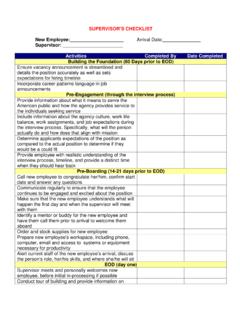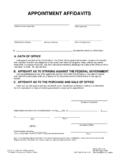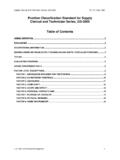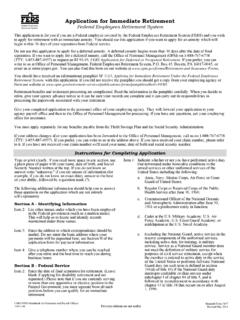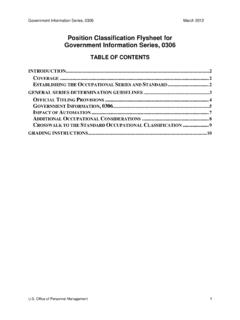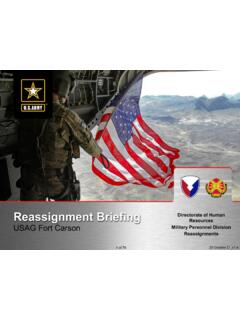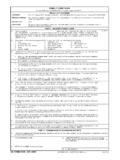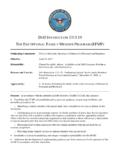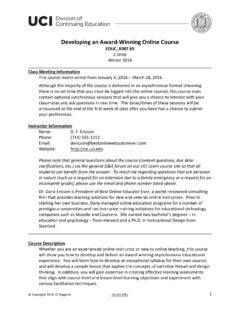Transcription of Handbook on Workplace Flexibilities and Work-Life …
1 Handbook on Workplace Flexibilities and work -LifePrograms for Elder CareJuly 2015 A Message from the Acting Director of the Office of Personnel Management On June 23, 2014, the President issued a memorandum entitled: Enhancing Workplace Flexibilities and Work-Life Programs. In this memorandum, the Office of Personnel Management (OPM) is directed to work with agencies to provide appropriate education and guidance to all agency employees, including managers and supervisors, on Workplace Flexibilities and Work-Life programs available for employees use. The memorandum also makes employees aware that they have a right to request work schedule Flexibilities , including telework, part-time employment, or job sharing, and directs that agency heads ensure that Workplace Flexibilities are available to employees, to the maximum extent practicable, in accordance with the laws and regulations governing these programs and consistent with mission needs.
2 On July 13, 2015, the White House Conference on Aging is hosting a conference that includes the challenges associated with elder caregiving. There are more than 40 million Americans already older than 65, with 10,000 more Americans joining their ranks every day. The statistics on aging predict that by the year 2050, the number of individuals age 65 or older living in the United States will exceed 88 million. As a result, an increasing number of Federal employees will face the challenge of caring for an aging family member in the coming years. To meet our commitment to provide education on Workplace Flexibilities and Work-Life programs, and to support the 2015 White House Conference on Aging, OPM is issuing a Handbook on Workplace Flexibilities and Work-Life Programs for Elder Care.
3 This Handbook provides guidance on the various leave and work schedule Flexibilities for elder care, and also provides information on Work-Life programs available to employees providing care for an elderly family member, including examples of how the programs can work together to help employees better manage family and work responsibilities. Promoting a culture in which managers and employees understand the Workplace Flexibilities and Work-Life programs available helps attract, empower, and retain a talented and productive workforce in the 21st century. Beth F. Cobert Acting Director 1 Handbook on Workplace Flexibilities and Work-Life Programs for Elder Care Contents I. Introduction.
4 3 II: Leave and work Schedule Flexibilities for Elder Care .. 6A. Sick Leave .. 6B. Advanced Sick Leave .. 8C. Annual Leave .. 9D. Advanced Annual Leave .. 9E. family and Medical Leave .. 10F. Leave Sharing Programs .. 12G. Leave Without 15H. Compensatory Time Off .. 15I. Alternative work Schedules .. 16J. Telework .. 18K. Remote work .. 19L. Part-time Employment and Job Sharing 20 III. work - life Programs for Elder Care .. 21A. Health-Related Benefits .. 21B. Employee Assistance Programs .. 21C. Dependent Care Programs .. 21IV. Overview of Workplace Flexibilities and Work-Life Programs .. 22A. Summary of Leave Programs Available for Elder Care.
5 22B. Differences between Sick Leave, Leave Sharing and FMLA .. 23C. Summary of work Schedule Flexibilities Available for Elder Care .. 24D. Interaction of Various Workplace Flexibilities and Work-Life Programs for Elder CareIllustrations .. 24 2 I. Introduction The Federal Government offers a wide array of Workplace Flexibilities and Work-Life programs that can be combined in many ways to achieve the type of flexibility that allows employees time off for elder caregiving needs. To build on our record of leadership through better education and training, the Office of Personnel Management (OPM) is providing this Handbook to provide assistance and demonstrate how these Flexibilities and programs work together to support employees who are providing elder care for a family member.
6 In doing so, we can help ensure that the Federal workforce is engaged and empowered to deliver exceptional and efficient service to the American public while simultaneously meeting the needs of their families. Roles and Responsibilities This Handbook provides various tools for employees to use in preparing and planning for time off for elder caregiving. It must be read in conjunction with agency and component-specific Flexibilities and program policies and, to the extent they comport with applicable law, any applicable collective bargaining agreements. The division of roles and responsibilities are provided below. OPM s Role. OPM provides leadership on Federal policies and programs by developing and maintaining Governmentwide rules and regulations on annual leave, sick leave, the family and Medical Leave Act, Federal leave sharing programs, alternative work schedules, part-time employment, and other Workplace Flexibilities and programs.
7 OPM also provides guidance on telework. Agencies Role. Federal agencies are responsible for complying with the law and OPM's Governmentwide regulations and guidance. Agencies are also responsible for developing agency-specific policies dealing with the administration of leave and other Workplace Flexibilities and programs, including any discretionary benefits, in accordance with appropriate provisions of any applicable collective bargaining agreements. Employees Role. Employees must review both OPM and agency-specific rules and regulations on leave and other Workplace Flexibilities and programs to understand the options available for taking time off for elder caregiving. It is equally important for employees to consult with their agency s servicing human resources office.
8 3 Employee Checklist for Planning for Time Off for Elder Caregiving The following checklist should be used as an organizational tool before meeting with your manager or servicing human resource office. (Note: Check with your servicing human resource office to confirm what Flexibilities are available at your agency.) Things to Do: Read the OPM Handbook on Workplace Flexibilities and Work-Life Programs for Elder Care Review relevant OPM fact sheets using the links in the Handbook Know your internal agency policies and guidelines for requesting and using leave and other Workplace Flexibilities For a need of fixed duration, determine the amount of time off you would like to take o Hours needed:_____ Determine your projected leave/paid time off balances at the time leave will be needed o Available sick leave hours: _____ o Available annual leave hours:_____ o Other available paid time off (compensatory time, credit hours): _____ o Amount of unpaid time off (LWOP) you wish to take.
9 _____ Determine the gap, if any, between the amount of time off you would like to take, versus the amount of leave/paid time off you will have available at the time leave will be needed o Hours of leave/paid time off hours wanted minus hours of leave/paid time off accrued: _____ Know Your Options: Advanced Sick Leave and Advanced Annual Leave o What options does my agency provide to repay advanced leave? o How will I repay the advanced leave? o Can I apply for donated annual leave to repay advanced leave? o How long will it take to repay my advanced leave? Voluntary Leave Transfer or Voluntary Leave Bank Programs o Will I be eligible to become a leave recipient? If so, how/when should I apply?
10 O If my agency has a leave bank, when is the open enrollment period? o Will I use donated annual leave to repay any potential advanced leave indebtedness? family and Medical Leave Act (FMLA) o Am I eligible for FMLA? o Will I be substituting paid leave for unpaid FMLA leave? If so, what type and how much? o Do I need to use FMLA leave intermittently? If so, be sure to let your manager know. Use of Leave on an Intermittent Basis o Will I need to use leave intermittently rather than in a block of time? If so, be sure to discuss with your manager. 4 Telework o Is situational or routine telework an option? Discuss with your manager. o Does my agency permit teleworking from an alternative work location outside of the local commuting area as an ad-hoc temporary flexibility?
